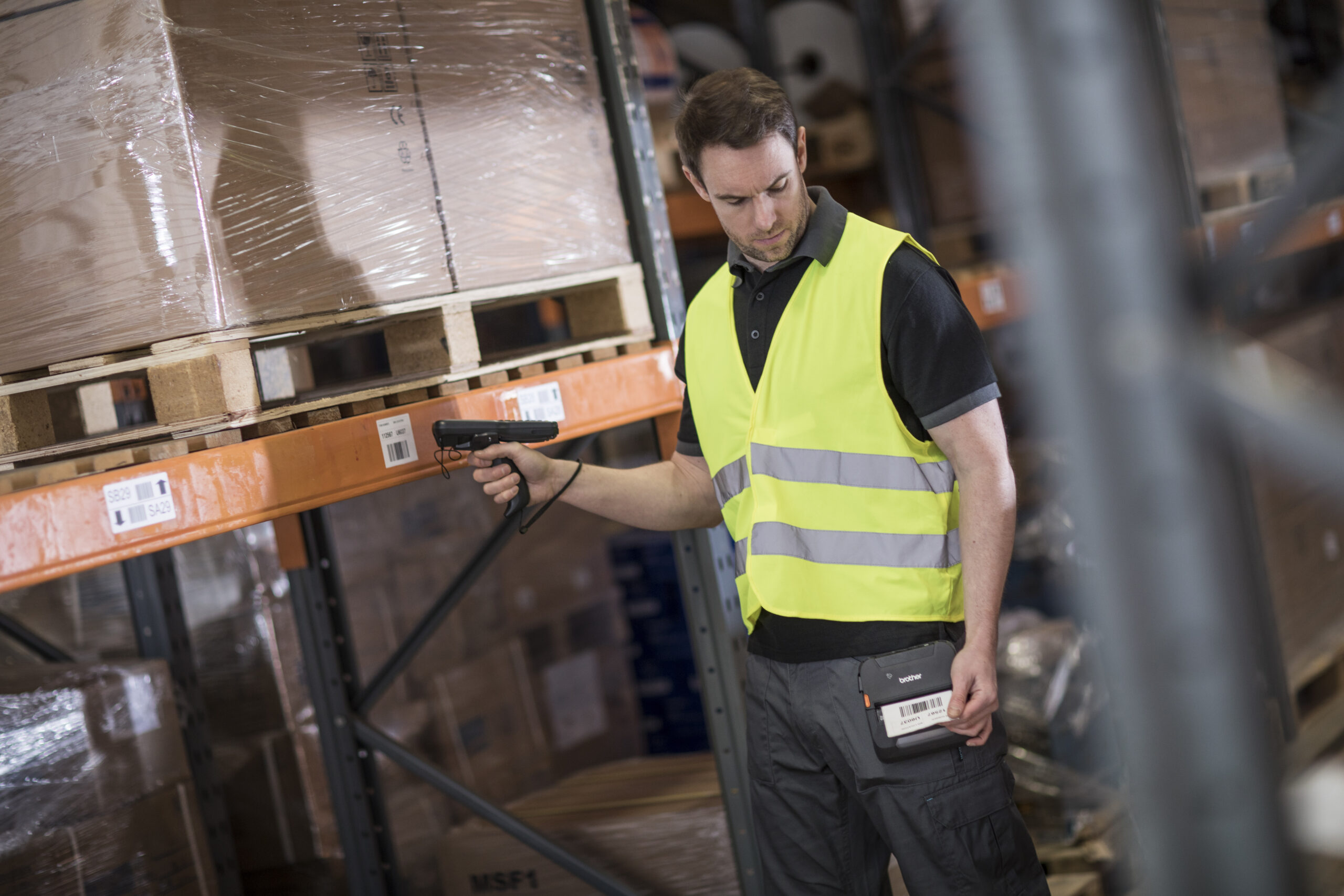Design & print industrial labels from your phone on the compact EDGE portable.

Experts identify the most promising targets for mobile printing sales today and point to trends that could affect the future.
With every article in Business Solutions, we strive to uncover the most significant trends. Oftentimes, we focus on new offerings and cutting-edge solutions. While the future certainly holds a lot of exciting new technologies, there are many technologies that have been around for decades but still are very important to their respective industries. Consider mobile printers and their importance within verticals such as retail, warehousing, and transportation, just to name a few. Despite their mission-critical nature, many take these workhorses for granted. At the same time, for as long as bar code printers have been around, some may wonder if there’s any room left for innovation. Has printing technology plateaued? Regardless of advancements, where is the low-hanging fruit for VARs and integrators? To learn answers to these questions and more, we sought the wisdom of a few industry experts.
Vertical Growth
Theresa Lee, thermal bar code product manager at Toshiba America, says the sales growth of mobile printers due to the rise of e-commerce is very impressive. In fact, she says that market is experiencing a growth rate of 6 to 8 percent annually as compared to the total U.S. retail sales growth rate of 3 percent. “E-commerce sales are expected to grow to a larger percentage of the total U.S. retail business in the future,” she says. “The distribution centers [DCs] supporting e-commerce fulfillments are now demanding more automated equipment to achieve higher efficiency to meet faster turnaround times and compressed shipping schedules. This market is primarily interested in automated pick, pack, and ship; print and apply systems; and process improvements such as voice picking or pick to lights systems. More specifically, the most common applications in this area are for shipping labels, pallet labels, product ID, bin, and shelf labels for the warehouse.”
She continues by explaining that her company sees demand for its double-sided printer in this market. “Overall, e-commerce fulfillment DCs are looking for equipment to streamline their labor-intensive pick, pack, and ship process,” she explains. “With the double-sided printer, DCs can streamline their process by combining the printing of a shipping label and a packing list into a single label.”
Of course, Lee also points to the retail industry’s current major transformation. “In store, we are seeing increased demand for mobile receipt printers for mPOS [mobile point of sales],” she says. “Some in-store applications are trending toward the use of Android or iOS handhelds or tablets, so there is increased demand for portable printers to support multiple mobile operating systems. Because of these new applications, we are seeing an expansion of portables for in-store use.” The most common in-store uses are merchandise price tags, markdown labels, apparel tags, receipts, and tickets.
Steve Sundstrom, GM of printing for Honeywell Safety and Productivity Solutions, says his reseller partners are seeing significant growth in the transportation and logistics industry. “Keeping track of goods through the entire distribution process is essential to control costs, increase productivity, and improve customer satisfaction,” he says. “Workers are always on the go, and being able to access and print valuable information streamlines their job by eliminating the need for making multiple trips to obtain vital documents. For transportation and logistics executives driven to change the competitive position of their enterprise, mobile bar code printing solutions drive more efficient, accurate, and transparent operations, which ultimately improves customer service.” As far as applications are concerned, Sundstrom points to three — package routing and delivery, DSD (direct store delivery), and route accounting.
Mobile Printing Features For Today
One might wonder what the future of mobile bar code printing looks like in terms of the printers themselves. For instance, does the future hold incremental growth (e.g., print speed) only, or are there still industry-shifting changes possible?
Sundstrom says, interestingly enough, the future is going to look a lot like the past. “Users have made it very clear they are more interested in easy-to-use and reliable printing devices,” he explains. “Within the industries mentioned above, efficiency is the most important job characteristic. Simple, easy-tounderstand, and easy-to-integrate printing devices are the preference. These devices are often used in applications that are critical to the success of the organization; whether it’s proper resource or package routing or the accurate capture of a revenue transaction, these printers must work efficiently and reliably during these key transactional periods.” With that said, he says we’re also seeing greater connectivity than ever before. Integration and linkage between mobile printers and enterprise mobile devices will continue to drive further gains in productivity. In the future, we will also see additional trends of mobile device management reaching into the printers.
David Crist, president of Brother Mobile Solutions, says his company has seen a rise in demand for features such as dual radio functionality, wireless connectivity, and operating system-agnostic compatibility. “Printer size, speed, and battery life will continue to be important,” he adds. “But more importantly, with the rise of IoT [Internet of Things], the bar code becomes the most fundamental way to add a digital voice to physical things, so they can be tracked, analyzed, and better understood. The future of bar codes is far from over. To the contrary, the ability to add and encode more and more info in a 2D bar code is becoming an area of much innovation. At the end of all this, you have to print a bar code label.”
So what printer tech is in demand? Thaddeus Szymanski, national sales manager for Seiko Instruments USA, says he is seeing end users, across all verticals, looking at printers in the 2- to 4-inch range. “This is because technology is not only becoming more simplified, but also so that workers within these verticals have their hands free to do other things, rather than be tied down by bulky and awkwardly sized equipment,” he says. “These specific size models are on a growth track because they also lend themselves to versatility, as they can be used within verticals such as hospitality and retail, as well as more rugged verticals like logistics and public utilities.” In addition, he says having a smaller size printer that is aesthetically pleasing, as well as tough on drops and day-to-day usage, is another feature that we will be seeing more of. “Versatility and ease of use seem to be top of mind for today’s end users,” he adds.
Trend Watch — Mobile Printing For Tomorrow
As mentioned at the outset and reaffirmed by our experts, mobile printing continues to see impressive growth in a variety of applications and verticals. Szymanski mentions a TechSci Research report, Global Mobile/Portable Printers Market Forecast & Opportunities, 2020, in which the mobile printer market is projected to exceed $13 billion through 2020. “This is expected to include everything from digital receipts printed out at your favorite department store, to pay at the table at your local restaurant,” he says. “The report also noted the affordability of thermal printers, the increasing mobile workforce, and growing need for on-the-go printing solutions — all of which are forecast to drive demand for thermal printers in the next few years.” Szymanski adds that the report found that “the integration of wireless technologies in mobile printers is expected to further boost adoption of mobile/portable printers for instant and high-quality printing.”
Perhaps the biggest trend driving growth is IoT. Indeed, Crist says that IoT and e-commerce are driving an enormous amount of bar code printing in retail to track and manage not only packages, but enterprise assets and equipment.
Lee says that with burgeoning technologies such as IoT and GPS on the horizon, the use of RFID to enable real-time visibility in the supply chain will increase. But until these technologies mature, bar code labeling will still be the most cost-effective technology for years to come.
Lastly, Sundstrom says he sees asset tracking and mobile device management as the biggest trends. “Businesses want to know where their assets are and how they are performing,” he explains. “Are they working effectively? Do they need maintenance? Are they the right solution for the worker application they have been deployed in? Implementing sensors that can monitor product use and efficiencies will provide organizations with those key data points that will allow them to predict and control expenses.” As companies move major portions of their businesses to cloud-based ERP systems, he says it only seems natural that the mobile devices used to drive worker needs and revenue capture will also be part of that cloud-based information center.

Talk to an expert
Set up your virtual product demo, training, or meeting today.
Schedule a digital demo



